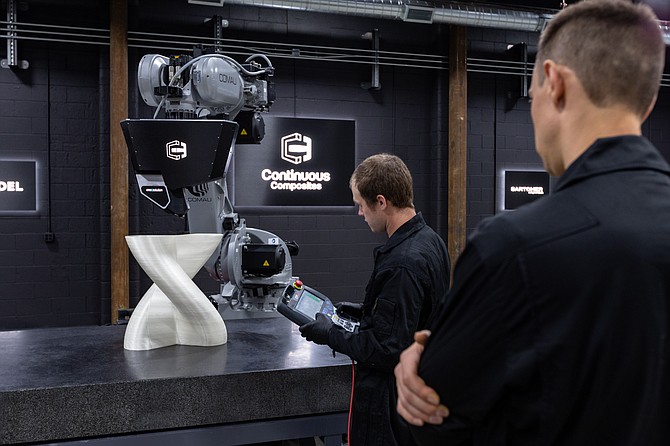Continuous Composites receives $750K Department of Defense contract

Sam VanDenBerg, left, and Tyler Wilson demonstrate Continuous Composites' capabilities of patented Continuous Fiber 3D Printing process and technology. The Coeur d'Alene company was recently awarded a $750,000 Phase II Small Business Innovation Research contract from the Department of Defense.
COEUR d’ALENE — Continuous Composites at 215 E. Lakeside Ave. in downtown Coeur d'Alene is now working with the U.S. Department of Defense.
The forward-thinking composites manufacturing company has been awarded a $750,000 Phase II Small Business Innovation Research contract to demonstrate its patented Continuous Fiber 3D Printing (CF3D) manufacturing process for a DOD multifunctional structural composite application through collaboration with the Air Force Research Laboratory. The research topic focuses on attritable structures, engines and sensors of autonomous unmanned aerial systems and space systems.
“We are honored to receive this Phase II SBIR Contract directly through the Department of Defense,” Continuous Composites CEO Tyler Alvarado said. "The AFRL is a long-standing customer who recognized early the disruptive capabilities of CF3D. Through this contract and others, we are committed to transforming DoD Operational Capabilities.”
Accelerating change while increasing complexity, unpredictability and mass, a primary objective of the United States Air Force Science and Technology Strategy is hampered by aerospace composite manufacturing techniques which require significant manufacturing time by a skilled workforce. Continuous Composites’ CF3D technology is an automated manufacturing solution that significantly reduces cost, weight and lead time while opening new capabilities for complex structural solutions. Its unique capabilities to introduce low-cost, topology-optimized structures directly align with low-cost attritable aircraft technology/platform initiatives.
The primary technical objectives of this contract are to fabricate an organically integrated wing spar and rib configuration into a single component, resulting in a completely unitized wing frame. The design for the topology-optimized wing structure will be generated using a disruptive AI software solution, Generative Design, in collaboration with the Advanced Structural Concepts division in the Aerospace Systems Directorate of the Air Force Research Lab.
Design inputs include CF3D’s print capabilities combined with the mechanical properties of high-performance thermoset resins and continuous carbon fiber. The CF3D-printed, unitized frame will be assembled with composite wing skins, resulting in a full-scale wing structure for an unmanned aircraft. A static wing test will be performed by the Air Force Research Lab to evaluate performance. Continuous Composites will document process data that will be compared to more traditional fabrication and assembly processes.
The contract will leverage CF3D as an automated commercial process providing a responsive solution to unpredictable manufacturing surge requirements within the DOD. This demonstration will showcase the emerging capabilities of CF3D by reimagining aerostructures while using a low-cost, fully automated manufacturing technology to print a monolithic composite component. This application demonstrates CF3D with its advanced material solutions developed in collaboration with materials partner, Arkema.
“A direct-to-Phase-II program provides us the opportunity to collaborate with this innovative team and their disruptive manufacturing technology to further develop CF3D’s capabilities for mission readiness,” AFRL/RXMS LCAAT manufacturing lead Craig Neslen said. "We are committed to evaluating and maturing Continuous Composites’ technology for advanced aerostructures, which will enable us to meet the challenging manufacturing demands of the DOD."










